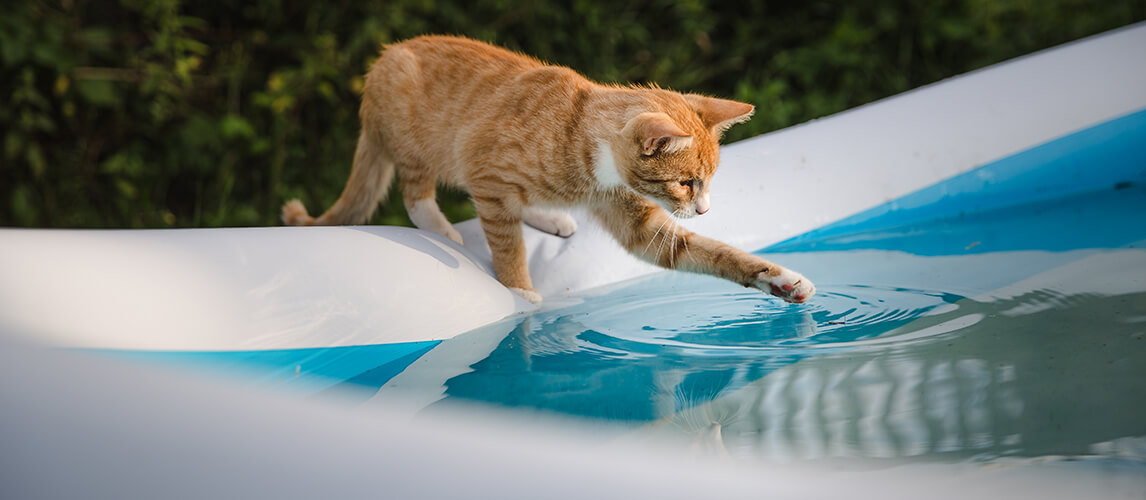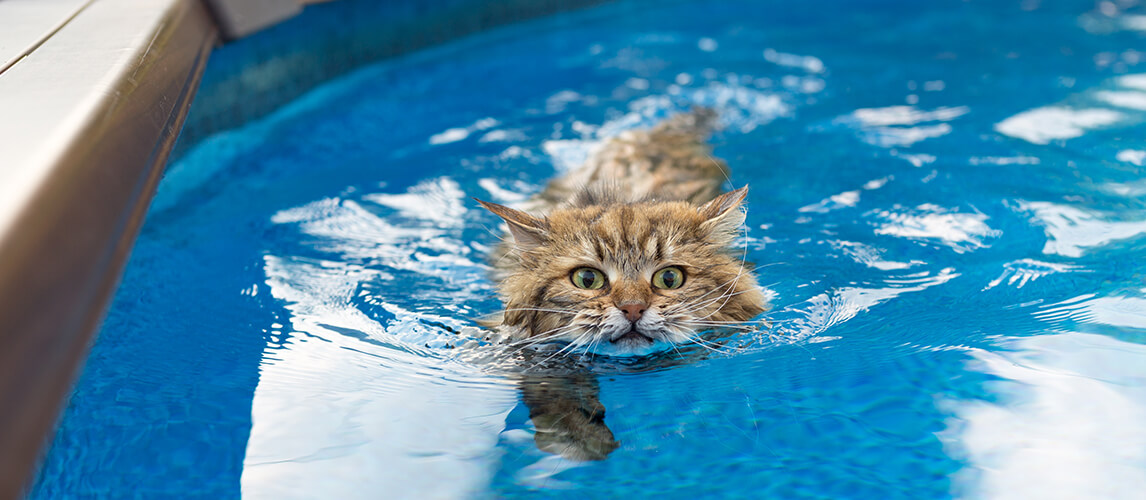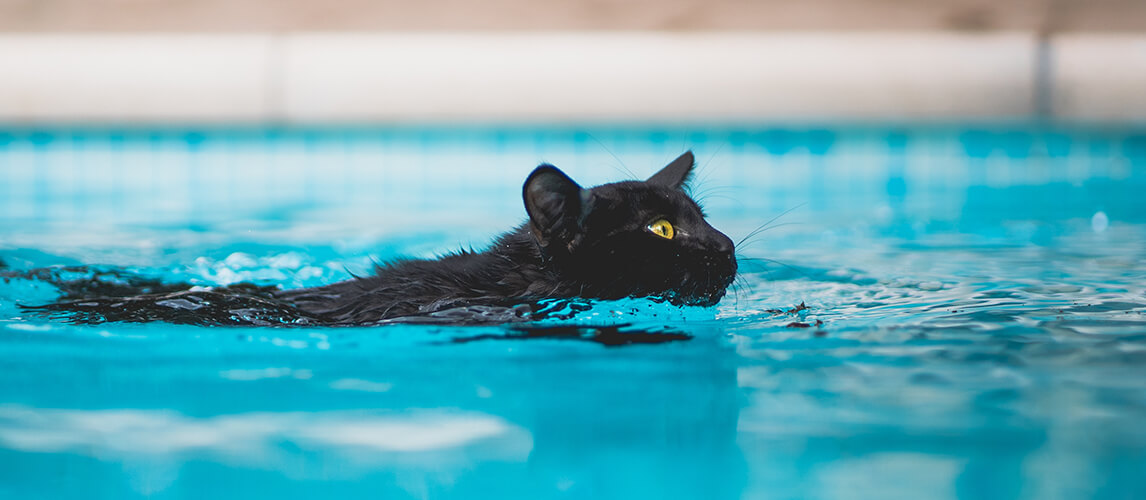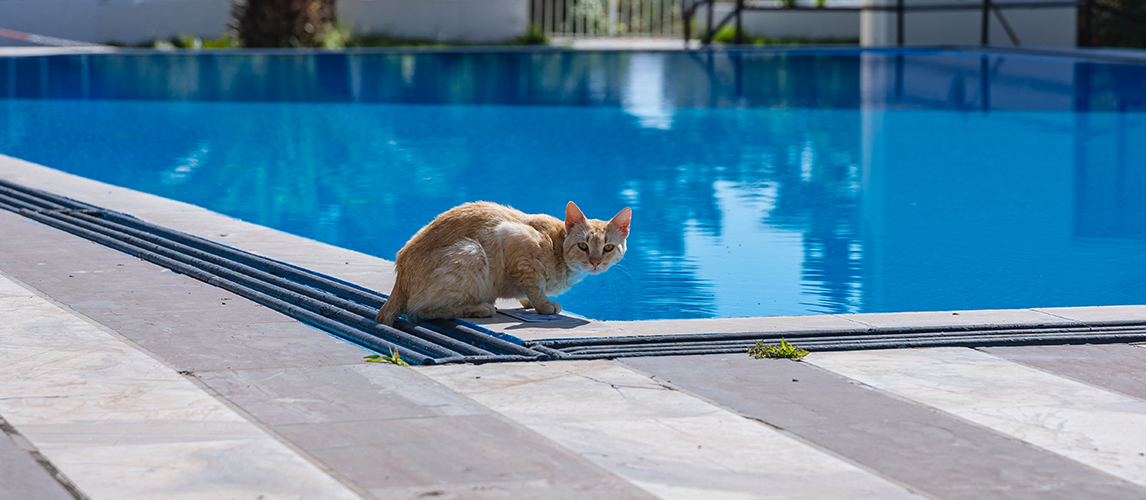The novelty of a domestic cat who enjoys swimming and bath time is something that we only seem to ever witness on the internet. It’s an adorable sight, but it often leaves other cat owners wondering why their cats seem to hate water so much when it’s clear that some cats absolutely love it. In this guide, we look to dive down deep into the world of swimming cats and bust open all the myths about them.
Can Cats Swim?

Despite the look of an unimpressed cat being hauled up out of their bath, cats can instinctually swim if they want to. Bathwater is often at a shallow enough level that your cat won’t attempt to swim when being forced to bathe, or they’ll just use their awesome power of getting out of the situation to jump out and run when they get a chance.
The reason that domesticated cats seem to carry a strong dislike of water is that they aren’t used to it. Because of their upbringing, they will not come across bodies of water unless their owners put them in that situation, which means that cats end up getting extremely anxious when given baths or when they accidentally fall in the bath.
Wild Cats and Swimming
In comparison, wild cats have more experience with large bodies of water. Jaguars are excellent swimmers and often inhabit rainforests and other areas where one might find lakes, rivers, and the like. They are certainly not the only large cat breed with this kind of natural habitat, nor are they the only wild cat that enjoys water and swimming.
When wild cat grows up in an environment where there is water, they become used to it. They may have to swim across rivers to hunt, and lakes and ponds will often act as their water bowl.
That said, not every wild cat will willingly jump into moving water. Some simply have no need to and have developed to hunt entirely on land. They’ll still drink from rivers etc., but they won’t feel the need to swim in them.
Did you know that cats won’t drink from stagnant water? This is a trait that has been passed on to domesticated cats, and it’s why your cat often hits the water in their bowl before drinking (and why some cats refuse to drink from non-moving water in a bowl).
Do Domestic Cats Like to Swim?
If they’re raised around water and introduced to bodies of water as kittens, a domestic cat will be able to swim and will enjoy it. When pushed to, all domestic cats have the instinctual ability to swim, but many will simply jump out of the water rather than spend a second longer in it than they need to.
Some domestic cat breeds really enjoy swimming, and it’s these cat breeds that you should consider adopting if you live near ponds, lakes, or rivers, or want to be able to take your cat to the beach. As cute as it might be to have your cat walking along the shore with you, they won’t go anywhere near the water if they aren’t comfortable with it, and forcing them into water will only end with you covered in scratches and a very unhappy cat.
Which Domestic Cat Breeds Like to Swim?
The following 10 domestic cat breeds absolutely love water and will do extremely well being brought up around it. Like any cat, though, they do need to be exposed to water early on in their life so they aren’t startled by it:
- Abyssinian cats
- American Bobtail cats
- Bengal cats
- Egyptian Mau cats
- Japanese Bobtail cats
- Maine Coon cats
- Manx cats
- Norwegian Forest cats
- Siberian cats
- Turkish Van cats
Are Cats Good Swimmers?

Cats can be great swimmers, but many need water confidence before they gain good swimming skills. Instincts will help your cat stay afloat and tread water if they need to, but without the confidence to start moving, they’ll never go anywhere.
Wild cats are often incredible swimmers, thanks to their strong muscles and streamlined bodies. As well as jaguars, you can expect to see lions, tigers, and panthers prowling around the water and occasionally going in for a cool swim. If you ever visit an area with a warmer climate that is home to a big cat breed, you might be lucky enough to witness them relaxing in the water when it’s hot.
How Do Cats Swim?
No matter their size or breed, cats swim by paddling their legs and keeping their head above water. It’s really no different from watching a dog paddle around in a pool or a toddler at their first set of swimming lessons. Paddling is the most instinctual form of swimming for animals, and they’ll always try to keep moving for fear of sinking down into the water. You certainly won’t see your cat trying to play the part of a mermaid.
Can you Teach a Cat to Swim?
Cats will largely learn to swim instinctively by trial and error after exposure to a large body of water. That may sound intimidating, but you can start introducing your cat to water with a bathtub or a kiddie pool. We definitely don’t recommend trying to put your cat in a full-size pool or a pond to help them learn how to swim.
With cats, it’s less teaching them how to swim and more training them to tolerate water. If your cat is afraid of water or has no experience with it, they’re going to panic. In the wild, adult cats will help their young learn how to swim, but domesticated cats don’t have that luxury.
As their human owner, you’ll need to work with your cat to help them figure out how to paddle. It might help to employ the use of your dog if you have one and your cat is friendly with them.
Keep a firm hold on your cat during their first few sessions in the water, and slowly move onto helping them move their legs so that they get the idea of paddling. It’s worth watching videos on teaching babies to swim and using your hands as your cat’s floaties until they’re comfortable to kick on their own.
Never leave your cat in or near a large body of water without supervision. Yes, they might be able to get themselves out, but if it’s too deep or too slippery, they may struggle.
Water Confidence in Cats
Water confidence is the biggest part of teaching your cat to swim. You should start building up their water confidence as early as possible. Wait until they’re a couple of months old (two or three months old should be fine, and many kittens have their first flea bath around this time anyway), and then start introducing them to small bodies of water.
The bathroom sink is a good starting point. It’s not as deep or intimidating as a bathtub, it’s easy to clean, and you’ll be able to keep a good grip on your cat. Start by sitting them in the sink and running warm water. Once they get comfortable, put the plug in and let the water fill up a little. This is the hardest part because your cat will be experiencing being surrounded by water for the first time.
Have a towel ready nearby and don’t worry if you need to repeat this first step several times until your kitten is comfortable.
Once they’re comfortable in the sink, try the bathtub. Raise the water level after each successful session until it’s high enough to start helping your cat float.
After the bathtub, we recommend a cheap kiddie pool or swimming pool. Inflatable pools may fall victim to your cat’s claws if they get scared, so do bear that in mind.
Our Top 10 Pool Safety Tips for Cats

- Don’t leave your cat by themselves in the pool if it’s full.
- Cover up pools when they aren’t in use.
- Act as your cat’s “water wings” and help them float while they’re learning to swim.
- Be patient during kitty swimming lessons.
- Don’t get mad at your cat if they scratch, bite, or claw you while learning. They’re scared.
- Older cats are harder to teach than younger cats, spend more time with them and keep sessions short in the beginning.
- If your cat starts to struggle, get them out of the water. You can always try again after they’ve calmed down.
- Give your kitty a small treat after each swimming session, even if you’re just introducing them to the water.
- It’s best to be in the water with your cat incase them struggle out of your hands. This is only relevant to pool training, rather than sinks and bathtubs.
- Play water games with your cat to help them feel safer around water.
Water Games for Cats
Playing water-based games with your cat is a great way to increase their confidence and help them realize that water isn’t scary. You could certainly turn on the sprinklers in your yard and let your cat have fun running through them, but a cat who is new to water may get startled by them.
To start with, place your cat in the bathtub while it’s empty and slowly fill it with just a couple of inches of water. Enough for your cat to get a little wet and for toys to float, but not so much that it overwhelms or scares them.
Once the water is ready, pop a few floating toys in the bath. There aren’t a huge number of buoyant cat toys out there, but there’s nothing wrong with getting your kitty some rubber ducks to play with. If you are looking for specific cat water toys for the bath, there are plenty of interactive fish available that most cats enjoy.
Remember that cats with long coats, like the Norwegian Forest cat and the Maine Coon cat, will drip water everywhere and it will take them a long time to dry off. Have a towel ready and keep them warm while their fur dries. Other cat breeds also need to be kept warm, but they will dry much quicker.
Why do Cats Hate Baths?

House cats have a reputation for hating baths but certain cat breeds do love water. Not all cats will react to water the same way, and it’s possible for any cat species to become confident around water. To get your cat swimming, simply spend time with them to introduce them to the feeling of water and help them learn how to activate their instinctual swimming skills. Cat swim sessions should be fun for you both!
The common reason that most domesticated cats hate baths is that they aren’t used to being submerged in water. Cat owners often make the mistake of filling up the bath too much and lowering their cat into it, rather than putting the cat in the bath first and letting them get used to the rising water level.
How to Tell if Your Cat is Afraid of Water
If your cats loathe water, they will let you know very quickly. Cats prefer to stay dry and though big cats may enjoy swimming, most domesticated cats aren’t used to it.
Cats instinctively jump out of water when they’re brought up in a domestic setting that hasn’t helped them with their water confidence. You can teach your cat to relax in the water and help them learn to swim, but if you don’t, they will never be comfortable sitting in the water.
When a cat wants to tell you they’re scared, its first action will be to cling onto you with their claws or run away from the situation so it can get back to “dry land”, as it were. If your cat commits to either of these actions, it’s safe to say you won’t get them in any swimming pools any time soon.
FAQs:
Q: Why does my cat like playing with water but hate baths?
A: Your cat has little to no water confidence and, therefore, is scared of being submerged in water. To get your cat to happily swim like other cats you’ve seen online, you’ll need to put some time and effort into helping them become more confident and calm around water. All cats can swim, but that doesn’t mean they want to be by the water’s edge or in the water.
Q: Can I put my cat in a kiddie pool?
A: A kiddie pool is a great step up from a bathtub. Full it with warm tap water while holding your cat gently. Warm water will help keep your cat’s body temperature normal, which is especially important when they’re kittens because kittens get cold very easily. Let your cat explore the pool while it’s filling and don’t be afraid to bring them back if they get out.

